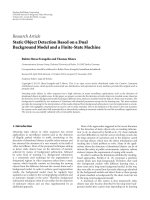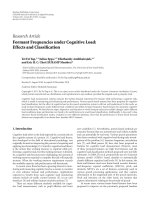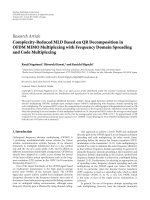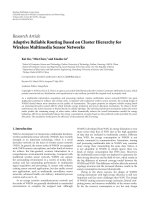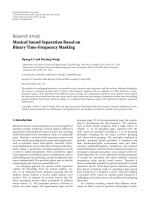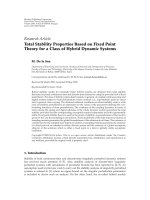Báo cáo hóa học: " Research Article Active Video Surveillance Based on Stereo and Infrared Imaging" doc
Bạn đang xem bản rút gọn của tài liệu. Xem và tải ngay bản đầy đủ của tài liệu tại đây (1.93 MB, 8 trang )
Hindawi Publishing Corporation
EURASIP Journal on Advances in Signal Processing
Volume 2008, Article ID 380210, 8 pages
doi:10.1155/2008/380210
Research Article
Active Video Surveillance Based on Stereo and
Infrared Imaging
Gabriele Pieri and Davide Moroni
Institute of Information Science and Technologies, Via G. Moruzzi 1, 56124 Pisa, Italy
Correspondence should be addressed to Gabriele Pieri,
Received 28 February 2007; Accepted 22 September 2007
Recommended by Eric Pauwels
Video surveillance is a very actual and critical issue at the present time. Within this topics, we address the problem of firstly
identifying moving people in a scene through motion detection techniques, and subsequently categorising them in order to identify
humans for tracking their movements. The use of stereo cameras, coupled with infrared vision, allows to apply this technique to
images acquired through different and variable conditions, and allows an a priori filtering based on the characteristics of such
images to give evidence to objects emitting a higher radiance (i.e., higher temperature).
Copyright © 2008 G. Pieri and D. Moroni. This is an open access article distributed under the Creative Commons Attribution
License, which permits unrestricted use, distribution, and reproduction in any medium, provided the original work is properly
cited.
1. INTRODUCTION
Recognizing and tracking moving people in video sequences
is generally a very challenging task, and automatic tools to
identify and follow a human “target” are often subject to con-
straints regarding the environment under investigation, the
characteristics of the target itself, and its full visibility with
respect to the background.
Current approaches regarding real-time target tracking
are based on (i) successive frame differences [1], using also
adaptive threshold techniques [2], (ii) trajectory tracking,
using weak perspective and optical flow [3], and (iii) re-
gion approaches, using active contours of the target and neu-
ralnetworksformovementanalysis[4], or motion detec-
tion and successive regions segmentation [5]. In recent years,
thanks to the improvement of infrared (IR) technology and
the drop of its cost, also thermal infrared imagery has been
widely used in tracking applications [6, 7]. Besides, the fu-
sion of visible and infrared imagery is starting to be explored
as a way to improve the tracking performance [8].
Regarding specific approaches for human tracking, frame
difference, local density maxima, and human shape models
are used in [9, 10] for tracking in crowded scenes, while face
and head tracking by means of appearance-based methods
and background subtraction are used in [11].
For the surveillance of wide areas, there is a need of
multiple-cameras coordination, in [12], there is a posterior
integration of the different single cameras tracks in a global
track using a probabilistic multiple-camera model.
In this paper, the problem of detecting a moving target
and its tracking is faced by processing multisource informa-
tion acquired using a vision system capable of stereo and IR
vision. Combining the two acquisition modalities assures dif-
ferent advantages consisting, first of all, of an improvement
of target-detection capability and robustness, guaranteed by
the strength of both media as complementary vision modal-
ities. Infrared vision is a fundamental aid when low-lighting
conditions occur or the target has similar colour to the back-
ground. Moreover, as a detection of the thermal radiation of
the target, the IR information can be manageably acquired
on a 24-hour basis, under suitable conditions. On the other
hand, the visible imagery, when available, has a higher resolu-
tion and can supply more detailed information about target
geometry and localization with respect to the background.
The acquired multisource information is firstly elabo-
rated for detecting and extracting the target in the current
frame of the video sequence. Then the tracking task is car-
ried on using two different computational approaches. A hi-
erarchical artificial neural network (HANN) is used during
active tracking for the recognition of the actual target, while,
2 EURASIP Journal on Advances in Signal Processing
when the target is lost or occluded, a content-based retrieval
(CBR) paradigm is applied on an a priori defined database to
relocalize the correct target.
In the following sections, we describe our approach,
demonstrating its effectiveness in a real case study, the
surveillance of known scenes for unauthorized access control
[13, 14].
2. PROBLEM FORMULATION
We face the problem of tracking a moving target distinguish-
able from a surrounding environment owing to a difference
of temperature. In particular, we consider overcoming light-
ing and environmental condition variation using IR sensors.
Humans tracking in a video sequence consists of two cor-
related phases: target spatial localization, for individuating
the target in the current frame, and target recognition, for
determining whether the identified target is the one to be fol-
lowed.
Spatial localization can be subdivided into detection and
characterization, while recognition is performed for an active
tracking of the target, frame by frame, or for relocalizing it,
by means of an automatic target search procedure.
The initialization step is performed using an automatic
motion-detection procedure. A moving target appearing in
the scene under investigation is detected and localized us-
ing the IR camera characteristics, and eventually the visible
cameras under the hypothesis to be working in a known en-
vironment with known background geometry. A threshold,
depending on the movement area (expressed as the number
of connected pixels) and on the number of frames in which
the movement is detected, is used to avoid false alarms. Then
the identified target is extracted from the scene by a rough
segmentation. Furthermore, a frame-difference-based algo-
rithm is used to extract a more detailed (even if more subject
to noise) shape of the target.
Once segmented, the target is described through a set of
meaningful multimodal features, belonging to morphologi-
cal, geometric, and thermographic classes computed to ob-
tain useful information on shape and thermal properties.
To cope with the uncertainty of the localization, in-
creased by partial occlusions or masking, an HANN can be
designed to process the set of features during an active track-
ing procedure in order to recognize the correctness of the de-
tected target.
In case the HANN does not recognize the target, wrong
object recognition should happen due to either a mask-
ing, partial occlusion of the person in the scene, or a quick
movement in an unexpected direction. In this circumstance,
the localization of the target is performed by an automatic
search, supported by the CBR on a reference database. This
automatic process is considered only for a dynamically com-
puted number of frames, and, if problems arise, an alert is
sent and the control is given back to the user.
The general algorithm implementing the above-de-
scribed approach is shown in Figure 1 and it regards its on-
line processing. In this case, the system is used in real time
to perform the tracking task. Extracted features from the se-
lected target drive active tracking with HANN and support
Spatial localization
Automatic target search
Recognition
Active tracking
Automatic search-next frame
Next frame
Next frame
Automatic search-next frame
DB
DB search
CBR result
Ta rg e t okTa rg e t ok
HANN
HANN
recognition
Target not recognized Target not recognized
Ta rg e t lo s t
Jframesskipped
Target selection
Detection
Images
Frame
segmentation
Characterization
feature extraction
Motion detection
Feature
integration
Semantic class
&
class change
Figure 1: Automatic tracking algorithm.
the CBR to resolve the queries to the database in case of lost
target. Before this stage, an off-line phase is necessary, where
known and selected examples are presented to the system so
that the neural network can be trained, and all the extracted
multimodal features can be stored in the database, which is
organised using predefined semantic classes as the key. For
each defined target class, sets of possible variations of the ini-
tial shape are also recorded, for taking into account that the
target could be still partially masked or have a different orien-
tation. More details of the algorithm are described as follows.
3. TARGET SPATIAL LOCALIZATION
3.1. Target detection
After the tracking procedure is started, a target is localized
and segmented using the automatic motion-detection pro-
cedure, and a reference point, called centroid C
0
, internal
to it is selected (e.g., the center of mass of the segmented
object detected as motion can be used for the first step).
This point is used in the successive steps, during the auto-
matic detection, to represent the target. In particular, start-
ing from C
0
, a motion-prediction algorithm has been defined
to localize the target centroid in each frame of the video se-
quence. According to previous movements of the target, the
current expected position is individuated, and then refined
through a neighborhood search, performed on the basis of
temperature-similarity criteria.
Let us consider the IR image sequence
{F
i
}
i=0,1,2,
,corre-
sponding to the set of frames of a video, where F
i
(p) is the
thermal value associated to the pixel p in the ith frame. The
trajectory followed by the target, till the ith frame, i>0, can
G. Pieri and D. Moroni 3
Function Prediction (i, {F
i
}
i=0,1,2,
, n);
//
∗
Check if the target has moved over a threshold
distance in last n frames
if
C
i−n
−C
i−1
>Thrshold
1
then
//
∗
Compute the expected target position P
1
i
in the current frame by interpolating the last n
centroid positions
P
1
i
= INTERPOLATE({C
j
}
j=i−n, ,i−1
);
//
∗
Compute the average length of the movements
of the centroid
d
=
i−2
j
=i−n
C
j
−C
j+1
/n −1;
//
∗
Compute a new point on the basis of temperature
similarity criteria in a circular neighborhood
Θ
d
of P
1
i
of radius d
P
2
i
= arg min
P∈Θ
d
[F
i
(P) − F
i−1
(C
i−1
)];
if
P
1
i
−P
2
i
> Threshold
2
then
P
3
i
= αP
1
i
+ βP
2
i
; //
∗
where α + β = 1
//
∗
Compute the final point in acircular
neighborhood N
r
of P
3
i
of radius r
C
i
= arg min
P∈N
i
[F
i
(P)−F
i−1
(P
i−1
)];
else
c
i
= P
2
i
;
else //
∗
Compute the new centroid according to
temperature similarity in a circular
neighborhood N
1
of the last centroid
C
i
= arg min
P∈N
l
[F
i
(P) − F
i−1
(P
i−1
)]
Return C
i
Algorithm 1: Prediction algorithm used to compute the candidate
centroid in a frame.
be represented as the centroids succession {C
j
}
j=0, ,i−1
.The
prediction algorithm for determining the centroid C
i
in the
current frame can be described as shown in Algorithm 1.
Where i isthe sequential number of the current frame,
{F
i
} is the sequence of frames, the number of frames con-
sidered for prediction is the last n,andF
i
(P) represents the
temperature of point P in the ith frame.
The coordinates of centroids referring to the last n frames
are interpolated for detecting the expected position P
1
i
.Then,
in a circular neighborhood of P
1
i
of radius equal to the aver-
age movement amplitude, an additional point P
2
i
is detected
as the point having the maximum similarity with the cen-
troid C
i−1
of the previous frame. If P
2
i
−P
1
i
> Threshold
2
,
then a new point P
3
i
is calculated as a linear combination
of the previous determined ones. Finally, a local maximum
search is again performed in the neighborhood of P
3
i
to make
sure that it is internal to a valid object. This search finds the
point C
i
that has the thermal level closest to the one of C
i−1
.
Starting from the current centroid C
i
, an automated edge
segmentation of the target is performed using a gradient de-
scent along 16 directions starting from C
i
. Figure 2 shows a
sketch of the segmentation procedure and an example of its
result.
Centroid
(a) (b)
Figure 2: Example of gradient descent procedure to segment a tar-
get (a) and its application to an example frame identifying a person
(b).
3.2. Target characterization
Once the target has been segmented, multisource informa-
tion is extracted in order to obtain a target description.
This is made through a feature-extraction process performed
on the three different images available for each frame in
the sequence. The sequence of images is composed of both
grey-level images (i.e., frames or thermographs) of a high-
temperature target (with respect to the rest of the scene) inte-
grated with grey-level images obtained through a reconstruc-
tion process [15].
In particular, the extraction of a depth index from the
grey-level stereo images, performed by computing disparity
of the corresponding stereo points [16], is realized in order
to have significant information about the target spatial local-
ization in the 3D scene and the target movement along depth
direction, which is useful for the determination of a possible
static or dynamic occlusion of the target itself in the observed
scene.
Other features, consisting in radiometric parameters
measuring the temperature and visual features, are extracted
from the IR images. There are four different groups of visual
features which are extracted from the region enclosed by the
target contour defined by the sequence of N
c
(i.e., in our case,
N
c
= 16) points having coordinates x
i
, y
i
.
Semantic class
The semantic class the target belongs to (i.e., an upstanding,
crouched, or crawling person) can be considered as an addi-
tional feature and is automatically selected, considering com-
binations of the above-defined features, among a predefined
set of possible choices and assigned to the target.
Moreover, a class-change event is defined, which is as-
sociated with the target when its semantic class changes in
time (different frames). This event is defined as a couple
SC
b
,SC
a
that is associated with the target, and represents
the modification from the semantic class SC
b
selected before
and the semantic class SC
a
selected after the actual frame,
important features to consider in order to retrieve when the
semantic class of the target changes are the morphological
4 EURASIP Journal on Advances in Signal Processing
features, and in particular, an index of the normal histogram
distribution.
Morphological: shape contour descriptors
The morphological features are derived extracting character-
ization parameters from the shape obtained through frames
difference during the segmentation.
To avoid inconsistencies and problems due to intersec-
tions, the difference is made over a temporal window of three
frames.
Let Δ(i
− 1,i)bethemodulusofdifference between the
frames F
i−1
and F
i
. Otsu’s thresholding is applied to Δ(i−1, i)
in order to obtain a binary image B(i
−1, i). Letting TS
i
to be
the target shape in the frame F
i
, heuristically we have
B(i
−1, i) = TS
i−1
TS
i
. (1)
Thus the target shape is approximated for the frame at time i
by the formula
TS
i
= B(i −1, i)
B(i,i +1). (2)
Once the target shape is extracted, first, an edge detection is
performed in order to obtain a shape contour, and second, a
computation of the normal in selected points of the contour
is performed in order to get a better characterization of the
target. These steps are shown in Figure 3.
Two morphological features, the normal orientation and
the normal curvature degree, based on the work by Berretti
et al. [17], are computed. Considering the extracted contour,
64 equidistant points
s
i
, t
i
are selected. Each point is char-
acterized by the orientation θ
i
of its normal and its curva-
ture K
i
. To define these local features, a local chart is used to
represent the curve as the graph of a degree 2 polynomial.
More precisely, assuming without loss of generality that, in a
neighborhood of
s
i
, t
i
, the abscissas are monotone, the fit-
ting problem
t
= as
2
+ bs + c (3)
is solved in the least square sense. Then we define
θ
i
= a tan
−
1
2as
i
+ b
,
K
i
=
2a
1+
2as
i
+ b
2
3/2
.
(4)
Moreover, the histogram of the normal orientation, dis-
cretized into 16 different bins, corresponding to the same di-
rections above mentioned is extracted.
Such a histogram, which is invariant for scale transfor-
mation and thus independent of the distance of the target,
will be used for a deeper characterization of the semantic
class of the target. This distribution represents an additional
feature to the classification of the target, for example, a stand-
ing person will have a far different normal distribution than
(a) (b)
(c) (d)
(e) (f)
Figure 3: Shape extraction by frames difference (top), edge detec-
tion superimposed on the original frame (centre), and boundary
with normal vector on 64 points (bottom). Left and right represent
two different postures of a tracked person.
a crawling one (see Figure 4), a vector [v(θ
i
)] of the normal
for all the points in the contour is defined, associated to a
particular distribution of the histogram data.
Geometric
Area
=
N
c
i=1
x
i
y
i+1
) −
y
i
x
i+1
2
,
Perimeter
=
N
c
i=1
x
i
−x
i+1
2
+
y
i
− y
i+1
2
.
(5)
G. Pieri and D. Moroni 5
Thermographic
Average Temp: μ
=
1
Area
p∈Ta r ge t
F
i
(p),
Standard dev.: σ
=
1
Area −1
p∈Ta r ge t
F
i
(p) −μ
2
,
Skewness: γ
1
=
μ
3
μ
3/2
2
,
Kurtosis: β
2
=
μ
4
μ
2
2
,
Entropy: E
=−
p∈Ta r ge t
F
i
(p)log
2
F
i
(x, y)
,
(6)
where μ
r
are moments of order r.
All the extracted information is passed to the recognition
phase in order to assess if the localized target is correct.
3.3. Target recognition
The target recognition procedure is realised using a hierar-
chical architecture of neural networks. In particular, the ar-
chitecture is composed of two independent network levels,
each using a specific network typology that can be trained
separately.
The first level focuses on clustering the different features
extracted from the segmented target; the second level per-
forms the final recognition, on the basis of the results of the
previous one
The clustering level is composed of a set of classifiers,
each corresponding to one of the aforementioned classes of
features. These classifiers are based on unsupervised self or-
ganizing maps (SOM) and the training is performed to clus-
ter the input features into classes representative of the pos-
sible target semantic classes. At the end of the training, each
network is able to classify the values of the specific feature set.
The output of the clustering level is an m-dimensional vec-
tor consisting of the concatenation of the m SOMs outputs
(in our case, m
= 3). This vector represents the input of the
second level.
The recognition level consists of a neural network clas-
sifier based on error backpropagation (EBP). Once trained,
such network is able to recognize the semantic class that can
be associated to the examined target. If the semantic class is
correct, as specified by the user, the detected target is rec-
ognized and the procedure goes on with the active tracking.
Otherwise, wrong target recognition occurs and the auto-
matic target search is applied to the successive frame in order
to find the correct target.
3.4. Automatic target search
When wrong target recognition occurs, due to masking, oc-
clusion, or quick movements in unexpected directions, the
automatic target search starts.
The multimodal features of the candidate target are com-
pared to the ones recorded in a reference database. A simi-
180 0
30
60
90
120
150
210
240
270
300
330
5
10
15
(a) (b)
180 0
30
60
90
120
150
210
240
270
300
330
2
4
6
(c) (d)
180 0
30
60
90
120
150
210
240
270
300
330
2
4
6
8
10
(e) (f)
180 0
30
60
90
120
150
210
240
270
300
330
5
10
15
(g) (h)
Figure 4: Distribution histogram of the normal (left) of targets hav-
ing different postures (right).
larity function is applied for each feature class [18]. In par-
ticular, we considered colour matching, using percentages
and colour values, and shape matching, using the cross-
correlation criterion, and the vector [v(θ
i
)] representing the
distribution histogram of the normal.
6 EURASIP Journal on Advances in Signal Processing
Extracted features
Ft
1
Ft
2
Ft
3
··· Ft
n
Query
?
Ft
1,k
Ft
2,k
Ft
3,k
···
Ft
n,k
Semantic
class 1
Semantic
class 2
.
.
.
If SC
2
Most similar
pattern
DB
F
1,i
F
2,i
F
3,i
···
F
n,k
F
1,k
F
2,k
F
3,k
···
F
n,i
Figure 5: Automatic target search supported by a reference database
and driven by the semantic class feature to restrict the number of
records.
In order to obtain a global similarity measure, each sim-
ilarity percentage is associated to a preselected weight, using
the reference semantic class as a filter to access the database
information.
For each semantic class, possible variations of the ini-
tial shape are recorded. In particular, the shapes to compare
with are retrieved in the MM database using information in a
set obtained considering the shape information stored at the
time of the initial target selection joined with the one of the
last valid shape.
If the candidate target shape has a distance, from at least
one in the obtained set, below a fixed tolerance threshold,
then it can be considered valid. Otherwise, the search starts
again in the next frame acquired [13].
In Figure 5, a sketch of the CBR, in case of automatic tar-
get search, is shown considering with the assumption that
the database was previously defined (i.e., off-line), and con-
sidering a comprehensive vector of features
Ft
k
for all the
above-mentioned categories.
Furthermore, the information related to a semantic class
change is used as a weight for possible candidate targets; this
is done considering that a transition from a semantic class
SC
b
to another class SC
a
has a specific meaning (e.g., a person
who was standing before and is crouched in the next frames)
in the context of a surveillance task, which is different from
other class changes.
The features of the candidate target are extracted from
a new candidate centroid, which is computed starting from
the last valid one (C
v
). From C
v
, considering the trajectory
of the target, the same algorithm as in the target-detection
step is applied so that a candidate centroid C
i
in the current
frame is found and a candidate target is segmented.
(a) (b) (c)
Figure 6: Tracking of a target person moving and changing posture
(from left to right: standing, crouched, and crawling).
With respect to the actual feature vector, if the most sim-
ilar pattern found in the database has a similarity degree
higher than a prefixed threshold, then the automatic search
has success and the target tracking for the next frame is per-
formed through the active tracking. Otherwise, in the next
frame, the automatic search is performed again, still consid-
ering the last valid centroid C
v
as a starting point.
If, after j
MAX
frames, the correct target has not yet been
grabbed, the control is given back to the user. The value
of j
MAX
is computed considering the Euclidean distance be-
tween C
v
and the edge point of the frame E
r
along the search
direction r, divided by the average speed of the target previ-
ously measured in the last f frames
{C
j
}
j=0, ,v
(7),
j
MAX
=
C
v
−E
r
v−1
j
=v−f
C
j
−C
j+1
/f
. (7)
4. RESULTS
The method implemented has been applied to a real case
study for video surveillance to control unauthorized access
in restricted-access areas.
Due to the nature of the targets to which the tracking
has been applied, using IR technology is fundamental. The
temperature that characterizes humans has been exploited to
enhance the contrast of significant targets with respect to a
surrounding background.
The videos were acquired using a thermo camera in the
8–12 μm wavelength range, mounted on a moving structure
covering 360
◦
pan and 90
◦
tilt, and equipped with 12
◦
and
24
◦
optics to have 320 × 240 pixel spatial resolution.
Both the thermo-camera and the two stereo high-
resolution visible cameras were positioned in order to ex-
plore a scene 100-meter far, sufficient in our experimental
environments. The frame acquisition rate ranged from 5 to
15 fps.
In the video-surveillance experimental case, during the
off-line stage, the database was built taking into account
different image sequences relative to different classes of
the monitored scenes. In particular, the human class has
been composed taking into account three different postures
(i.e., upstanding, crouched, and crawling) considering three
G. Pieri and D. Moroni 7
Figure 7: Example of an identified and segmented person during
video surveillance on a gate.
Figure 8: Example of an identified and segmented person during
video surveillance in a parking lot.
different people typologies (short, middle, and tall) (see
Figure 6).
A set of surveillance videos were taken during night time
and positioned in specific areas, such as a closed parking lot
and an access gate to a restricted area, for testing the effi-
ciency of the algorithms. Both areas were under suitable illu-
mination conditions to exploit visible imagery.
The estimated number of operations, performed for each
frame when tracking persons, consists of about 5
·10
5
op-
erations for the identification and characterization phases,
while the active tracking requires about 4
·10
3
operations.
This assures the real-time functioning of the procedure on a
personal computer of medium power. The automatic search
process can require a higher number of operations, but it is
performed when the target is partially occluded or lost due to
some obstacles, so it can be reasonable to spend more time in
finding it, thus losing some frames. Of course, the number of
operations depends on the relative dimension of the target to
be followed, that is, bigger targets require a higher effort to
be segmented and characterized.
Examples of persons tracking and class identification are
shown in Figures 7 and 8.
The acquired images are preprocessed to reduce the
noise.
5. CONCLUSION
A methodology has been proposed for detection and tracking
of moving people in real-time video sequences acquired with
two stereo visible cameras and an IR camera mounted on a
robotized system.
Target recognition during active tracking has been
performed, using a hierarchical artificial neural network
(HANN). The HANN system has a modular architecture
which allows the introduction of new sets of features in-
cluding new information useful for a more accurate recog-
nition. The introduction of new features does not influence
the training of the other SOM classifiers and only requires
small changes in the recognition level. The modular archi-
tecture allows the reduction of local complexity and, at the
same time, the implemention of a flexible system.
In case of automatic searching of a masked or occluded
target, a content-based retrieval paradigm has been used for
the retrieval and comparison of the currently extracted fea-
tures with the previously stored in a reference database.
The achieved results are promising for further improve-
ments as the introduction of additional new characterizing
features and enhancement of hardware requirements for a
quick response to rapid movements of the targets.
ACKNOWLEDGMENTS
This work was partially supported by the European Project
Network of Excellence MUSCLE—FP6-507752 (Multimedia
Understanding through Semantics, Computation and Learn-
ing). We would like to thank M. Benvenuti, head of the R&D
Department at TD Group S.p.A., for his support and for al-
lowing the use of proprietary instrumentation for test pur-
poses. We would also like to thank the anonymous referee
for his/her very useful comments.
REFERENCES
[1] A. Fernandez-Caballero, J. Mira, M. A. Fernandez, and A. E.
Delgado, “On motion detection through a multi-layer neural
network architecture,” Neural Networks, vol. 16, no. 2, pp. 205–
222, 2003.
[2] S. Fejes and L. S. Davis, “Detection of independent motion us-
ing directional motion estimation,” Computer Vision and Im-
age Understanding, vol. 74, no. 2, pp. 101–120, 1999.
[3] W. G. Yau, L C. Fu, and D. Liu, “Robust real-time 3D trajec-
tory tracking algorithms for visual tracking using weak per-
spective projection,” in Proceedings of the American Control
Conference (ACC ’01), vol. 6, pp. 4632–4637, Arlington, Va,
USA, June 2001.
[4] K. Tabb, N. Davey, R. Adams, and S. George, “The recognition
and analysis of animate objects using neural networks and ac-
tive contour models,” Neurocomputing, vol. 43, pp. 145–172,
2002.
[5]J.B.KimandH.J.Kim,“Efficient region-based motion seg-
mentation for a video monitoring system,” Pattern Recognition
Letters, vol. 24, no. 1–3, pp. 113–128, 2003.
[6] M. Yasuno, N. Yasuda, and M. Aoki, “Pedestrian detection
and tracking in far infrared images,” in Proceedings of IEEE
Computer Society Conference on Computer Vision and Pattern
8 EURASIP Journal on Advances in Signal Processing
Recognition (CVPR ’04), pp. 125–131, Washington, DC, USA,
June-July 2004.
[7] J. Zhou and J. Hoang, “Real time robust human detection and
tracking system,” in Proceedings of the 2nd Joint IEEE Interna-
tional Workshop on Object Tracking and Classification in and
Beyond the Visible Spectrum, San Diego, Calif, USA, June 2005.
[8] B. Bhanu and X. Zou, “Moving humans detection based on
multi-modal sensory fusion,” in Proceedings of IEEE Workshop
on Object Tracking and Classification Beyond the Visible Spec-
trum (OTCBVS ’04), pp. 101–108, Washington, DC, USA, July
2004.
[9] C. Beleznai, B. Fruhstuck, and H. Bischof, “Human tracking
by mode seeking,” in Proceedings of the 4th International Sym-
posium on Image and Signal Processing and Analysis (ISPA ’05),
vol. 2005, pp. 1–6, Nanjing, China, November 2005.
[10] T. Zhao and R. Nevatia, “Tracking multiple humans in com-
plex situations,” IEEE Transactions on Pattern Analysis and Ma-
chine Intelligence, vol. 26, no. 9, pp. 1208–1221, 2004.
[11] A. Utsumi and N. Tetsutani, “Human tracking using multiple-
camera-based head appearance modeling,” in Pro ceedings of
the 6th IEEE International Conference on Automatic Face and
Gesture Recognition (AFGR ’04), pp. 657–662, Seoul, Korea,
May 2004.
[12] T. Zhao, M. Aggarwal, R. Kumar, and H. Sawhney, “Real-
time wide area multi-camera stereo tracking,” in Proceed-
ings of IEEE Computer Society Conference on Computer Vision
and Pattern Recognition (CVPR ’05), vol. 1, pp. 976–983, San
Diego, Calif, USA, June 2005.
[13] M. G. Di Bono, G. Pieri, and O. Salvetti, “Multimedia target
tracking through feature detection and database retrieval,” in
Proceedings of the 22nd International Conference on Machine
Learning (ICML ’05), pp. 19–22, Bonn, Germany, August 2005.
[14] S. Colantonio, M. G. Di Bono, G. Pieri, O. Salvetti, and M.
Benvenuti, “Object tracking in a stereo and infrared vision sys-
tem,” Infrared Physics and Technology, vol. 49, no. 3, pp. 266–
271, January 2007.
[15] M. Sohail, A. Gilgiti, and T. Rahman, “Ultrasonic and stereo
vision data fusion,” in Proceedings of the 8th International Mul-
titopic Conference (INMIC ’04), pp. 357–361, Lahore, Pakistan,
December 2004.
[16] O. Faugeras and Q T. Luong, The Geometry of Multiple Im-
ages, The MIT press, Cambridge, Mass, USA, 2004.
[17] S. Berretti, A. Del Bimbo, and P. Pala, “Retrieval by shape sim-
ilarity with perceptual distance and effective indexing,” IEEE
Transactions on Multimedia, vol. 2, no. 4, pp. 225–239, 2000.
[18] P. Tzouveli, G. Andreou, G. Tsechpenakis, Y. Avrithis, and S.
Kollias, “Intelligent visual descriptor extraction from video se-
quences,” in Proceedings of the 1st International Workshop on
Adaptive Multimedia Retrieval (AMR ’04), vol. 3094 of Lecture
Notes in Computer Science, pp. 132–146, Hamburg, Germany,
September 2004.

